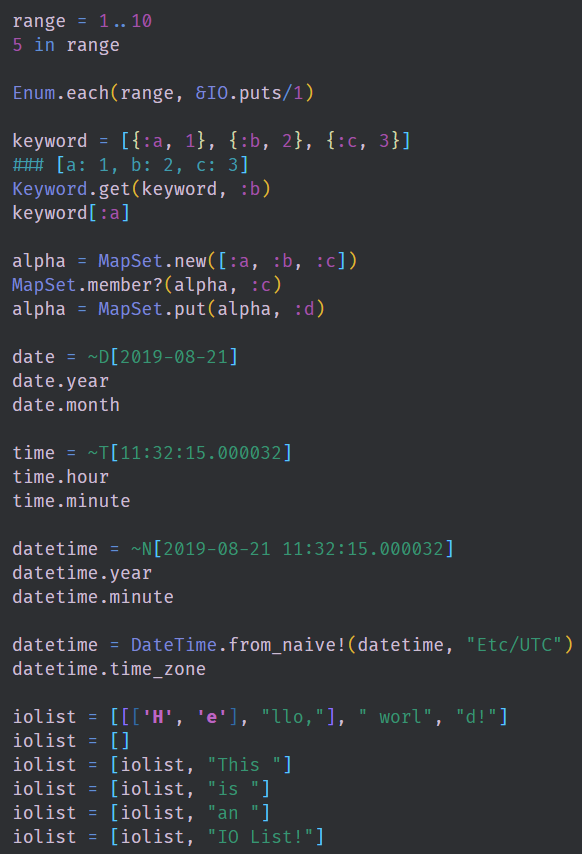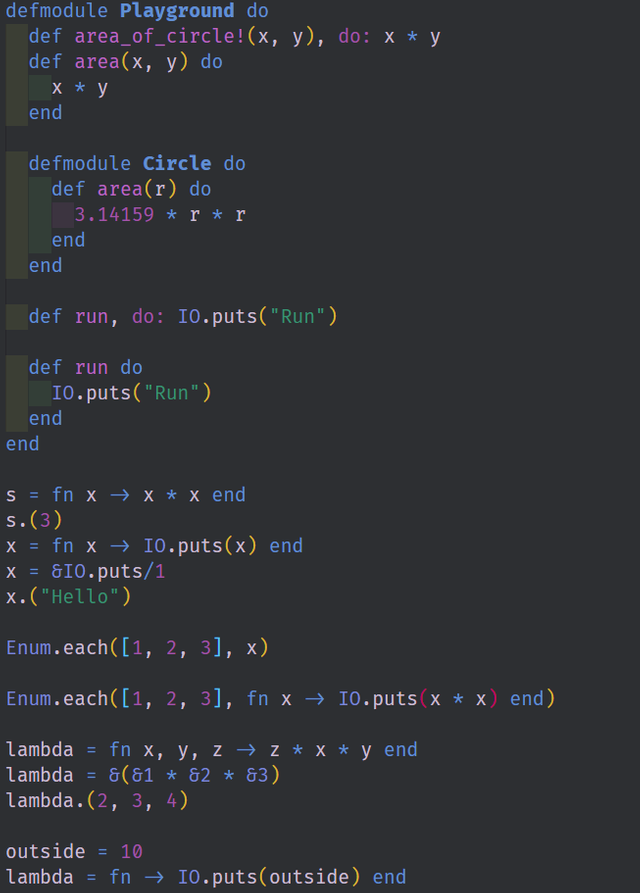Introduction to Elixir - Functions, Built-in and Complex Types - Part Two

Repository: https://github.com/elixir-lang/elixir
What Will I Learn?
- How to create and use Functions in Elixir
- How to use the Erlang built in types such as Ranges, Keyword Lists, MapSet, DateTime, and IOList
- How to use Closure Functions to shallow copy variables
- How to create anonymous functions and bind them to variables
- How to use the
defanddefmoduleconstructs and the Observer GUI
Requirements
System Requirements:
- Elixir v1.8 requires Erlang 20.0 or later
OS Support for Elixir and Phoenix:
- Mac OSx
- Unix and Linux
- Windows
- Raspberry Pi
- Docker
Required Knowledge
- Some basic Programming Knowledge
- An Elixir installation
- VsCode or any other Text Editor
Resources for Elixir and Phoenix:
- Elixir Website: https://elixir-lang.org
- Elixir Installation Instructions: https://elixir-lang.org/install.html
- Awesome Elixir Github: https://github.com/h4cc/awesome-elixir
- Phoenix Website: https://phoenixframework.org/
- Phoenix Installation Instructions: https://hexdocs.pm/phoenix/installation.html
- Elixir Documentation: https://elixir-lang.org/docs.html
- Phoenix Documentation: https://hexdocs.pm/phoenix/Phoenix.html
- LiveView Github Repository: https://github.com/phoenixframework/phoenix_live_view
Sources:
- Elixir Image: https://elixir-lang.org
Difficulty
- Beginner
Description
In this Elixir Video Tutorial, we continue on from the first video and expand upon our knowledge of the Types available in the language. We look at the Complex and Builtin types such as the Range type, the MapSet type, the Process ID type, IOLists and DateTime types. We also look at the Function type and it's many first class features in the Elixir Language.
Builtin and Complex Types in the BEAM
Despite being a Dynamic language, Elixir has a large amount of primitive and complex types built into it. All of these Complex Types are types that were coupled into the BEAM system for various reasons. For instance, the reference type is a unique piece of information which is guaranteed to be unique so long as the BEAM instance continues to run. There is also the Process ID type or pid which is used to identify Erlang processes; a main principle of the Actor Model. Other Higher Level types include the Range type, the Keyword List type, the MapSet type, Date and Time types and IO Lists.

The image above features many of these Complex Types and operators associated with them. At the top we have a basic range type; defined between 1 and 5 using double dots ... The range is an abstraction that gives us a memory efficient way of representing a range of numbers. Keyword lists are a special type of list composed of two element tuples where the first element in each tuple is an atom. These are often used as small size key value structures. The MapSet is similar to the HashSet from other languages; its a store of unique values but it doesn't preserve the ordering of each value. The Date and Time types are fairly self explanatory as types that define dates and times as well as both combined. Finally, we have IO Lists; which are a special type of list used in Input/Output operations. IO Lists are extremely useful for building streams of bytes and they are much more efficient then normal list structures due to their nested nature.
Functions and Function Types in Elixir
At its core, Elixir is a functional programming language. Naturally, this means that Functions are first class types in Elixir. You can bind functions to variables, pass them to other functions and even return them from other functions. This gives rise to the concept of Lambda functions and Closures as well as Anonymous functions and named functions.

This image shows some basic examples of the different types of functions in Elixir. At the top we have a Module defined as Playground. Inside of it is a single line function called area_of_circle and below that is a function called area. These two functions are identical to one another except area_of_circle uses syntactic sugar to be defined on a single line. Outside of the Module, we have a few anonymous functions. There are two Anonymous functions, one bound to the variable s and another one bound to x. The s function just takes a variable and multiplies itself by itself. the function in x takes a single argument and calls the IO.puts/1 function with it. Down below is an example of passing a function to another function. With the Enum.each/2 function we can apply a callback function to each value in an enumerable. In this case we are applying the x function to each element of a list. At the very bottom we have a function called lambda which is a closure. It uses a variable defined outside of the function body and by doing so, it makes a shallow copy of this variable. This means that even should the variable's data be rebound, the copy attached to the function will not.
Full Github Source Code can be found here: https://github.com/tensor-programming/intro-to-elixir/tree/tensor-programming-part-2
Hi @tensor
This is a new series of tutorials. I missed Part 1. This Part 2 is good with a lot of detail in creating and using the functions in Elixir.
As always, it is easy to follow your tutorial. Your competence helps your learners grasp the concepts easily.
Your contribution has been evaluated according to Utopian policies and guidelines, as well as a predefined set of questions pertaining to the category.
To view those questions and the relevant answers related to your post, click here.
Need help? Chat with us on Discord.
[utopian-moderator]
As always, thanks @rosatravels for moderating my contribution. @yokunjon moderated the first part and I was pretty impressed with his work as well.
Thank you for your review, @rosatravels! Keep up the good work!
Hi @tensor!
Your post was upvoted by @steem-ua, new Steem dApp, using UserAuthority for algorithmic post curation!
Your post is eligible for our upvote, thanks to our collaboration with @utopian-io!
Feel free to join our @steem-ua Discord server
Hi, @tensor!
You just got a 6.23% upvote from SteemPlus!
To get higher upvotes, earn more SteemPlus Points (SPP). On your Steemit wallet, check your SPP balance and click on "How to earn SPP?" to find out all the ways to earn.
If you're not using SteemPlus yet, please check our last posts in here to see the many ways in which SteemPlus can improve your Steem experience on Steemit and Busy.
Hey, @tensor!
Thanks for contributing on Utopian.
We’re already looking forward to your next contribution!
Get higher incentives and support Utopian.io!
Simply set @utopian.pay as a 5% (or higher) payout beneficiary on your contribution post (via SteemPlus or Steeditor).
Want to chat? Join us on Discord https://discord.gg/h52nFrV.
Vote for Utopian Witness!
Congratulations @tensor! You have completed the following achievement on the Steem blockchain and have been rewarded with new badge(s) :
You can view your badges on your Steem Board and compare to others on the Steem Ranking
If you no longer want to receive notifications, reply to this comment with the word
STOPDo not miss the last post from @steemitboard:
Vote for @Steemitboard as a witness to get one more award and increased upvotes!
This post has been voted on by the SteemSTEM curation team and voting trail. It is elligible for support from @curie.
If you appreciate the work we are doing, then consider supporting our witness stem.witness. Additional witness support to the curie witness would be appreciated as well.
For additional information please join us on the SteemSTEM discord and to get to know the rest of the community!
Please consider setting @steemstem as a beneficiary to your post to get a stronger support.
Please consider using the steemstem.io app to get a stronger support.